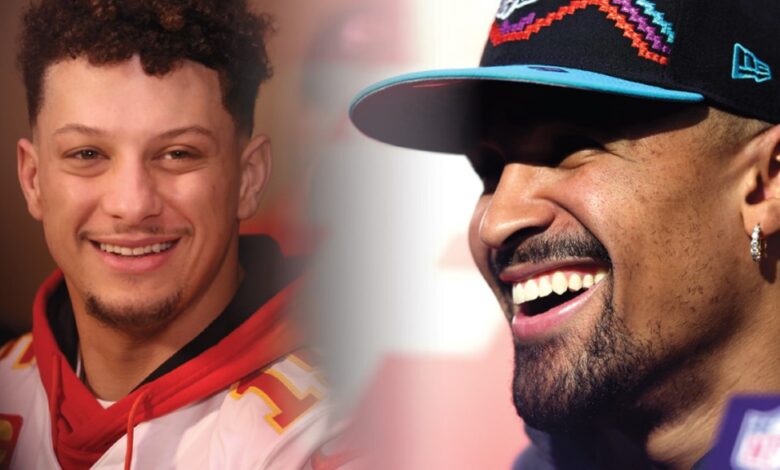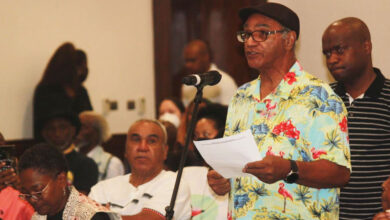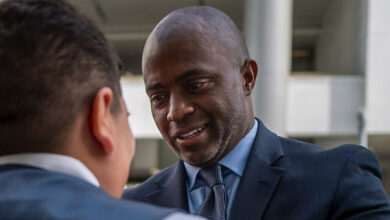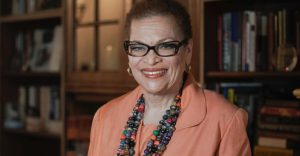Black History at The Super Bowl


ABOVE: (L) Patrick Mahomes #15 of the Kansas City Chiefs (Photo by Christian Petersen/Getty Images) (R) Jalen Hurts #1 of the Philadelphia Eagles (Photo by Christian Petersen/Getty Images)
This year’s Super Bowl will make Black History.
The Philadelphia Eagles will face the Kansas City Chiefs in Glendale, AZ on Feb. 12. Regardless of the outcome, this game is already historic. For the first time, the Super Bowl will start two Black quarterbacks.
Eagles quarterback Jalen Hurts led his team to a 31-7 trouncing of the San Francisco 49ers on Sunday afternoon. And Chiefs quarterback Patrick Mahomes overcame a high-ankle sprain to rally the Chiefs to a 23-20 win over the Cincinnati Bengals on Sunday evening. Now, the two QBs will lead their teams into sports’ biggest night. And when they meet on the field, it will be the first time in NFL HISTORY two Black quarterbacks are starting in the same Super Bowl — a game that was first played in 1967.
Mahomes is only the third Black quarterback to win a Super Bowl. (Doug Williams won with Washington in 1988; Russell Wilson led the Seattle Seahawks to victory in 2014. Mahomes and the Chiefs won in February 2020.) If the Eagles win, Hurts becomes only the fourth Black quarterback to win the Lombardi Trophy. If the Chiefs win, Mahomes will be the only Black QB to win multiple Super Bowls.
In a weekly appearance on 610 radio, Mahomes reflected on the importance of this moment. “I am proud. We came a long way,” said Mahomes. “As I’ve gotten into the NFL and learned more about the history of the Black quarterback, I’m happy that we’re going to be on this stage. It couldn’t be against a better guy than Jalen Hurts… I’m glad that we’re going to be able to represent the Black quarterback in the biggest game of them all.”
Texas Connection
Interestingly enough, both Hurts and Mahomes are from Texas. Mahomes was born in Tyler, TX, a northeastern city approximately 100 miles from Dallas. Hurts is from Channelview, a suburb eight miles southeast of Houston, TX. He went to Channelview High School (where his father coached the football team).
Because of their fathers’ careers, both quarterbacks grew up surrounded by sports. Mahomes grew up around baseball; his dad, Pat Mahomes Sr., played baseball in the MLB from 1992 to 2003. He was a shortstop and reliever for several teams, including the Minnesota Twins from 1992-96. (Mahomes Jr. was born in 1995, during his dad’s tenure with the Twins.)
“He basically grew up in the clubhouse with me,” Mahomes Sr. told the Lubbock Avalanche-Journal in 2015. “When he turned five years old, I was playing with the Mets at the time and we went to the NLCS, and then the next year to the World Series.”
“When we were in the World Series, I would let him go out to center field with me and let him shag balls,” Mahomes Sr. said. “The coaches were wary that he was going to get hit. But I told them that if he gets hit one time, he will learn — then he won’t do it again.”
Sure enough, young Patrick started catching fly balls in the outfield. And he played with his dad at home, too. His father told The Ringer that Patrick “graduated” from playing catch in the family’s backyard when he was around 10 years old. By that age, he could throw a baseball over the outfield fence from home plate, a distance he estimated is between 200 and 220 feet. “We had a pretty big backyard,” Pat Mahomes said. “But it always got to the point where he needed enough room to throw the ball. We went to the baseball field, and eventually the football field.”

Pat Mahomes Sr. and son, Patrick Mahomes Jr.
“When I first started with him, I thought I was preparing a football player,” Mahomes Sr. told The Ringer. “So, I taught him some of the things that helped me build arm strength and he made it his own thing.”
One of those things was the long toss. According to Metro League, “Long toss is a baseball drill in which the pitcher throws to a fielder at least 60 yards from home plate. The aim of long toss is to improve arm strength and accuracy, as well as increase distance between thrower and target.”
Mahomes uses long toss now as part of his warm-ups for football practice. “My dad has had me long tossing since, well, forever. I think that helped build arm strength, helped build accuracy and touch,” Mahomes said. “That’s something that I’ve always done. I brought it immediately into football.”
Patrick played football and baseball in high school. He even got drafted by the Detroit Tigers. But Patrick Mahomes chose football instead — and the rest is history.
Mahomes had 16 TDs and 4 interceptions as a freshman, according to Business Insider. He broke out the following season, throwing for over 4,000 yards, 36 touchdowns, and 15 interceptions. Mahomes continued to improve his junior year, throwing over 5,000 yards with 41 touchdowns, and 10 interceptions. He set the NCAA record with 819 total yards of offense in a loss to Baker Mayfield and Oklahoma.
Mahomes took his talents to the NFL. The Kansas City Chiefs drafted him in 2017. He had a breakout season the next year. And when Mahomes suffered a dislocated kneecap in 2019, his dad was there.
Pat Mahomes Sr. hadn’t planned to attend the Chiefs-Broncos game that night. But a dream about his son made him change his mind. “I wasn’t gonna go. [But] I had a dream — on like, that Wednesday — that he was gonna get hurt,” he said. “I went to the game, and sure enough, in the 2nd quarter, he went down — on a quarterback sneak, out of all plays.”
“I know him,” the elder Mahomes said. “And he’s like me; if he can get up, he’s gonna get up. When he didn’t get up, I got scared, so I ran down and was able to go see him and make sure that he’s OK.”
He was. Thankfully, staff popped Patrick’s kneecap back into place, and he recovered enough to help win Kansas City’s first Super Bowl since 1970.

Jalen Hurts pictured with family and father Averion Hurts Sr. (right)
Jalen Hurts grew up around sports, too. His father Averion Hurts, Sr., coaches the football team at Channelview High School. He coached both Jalen and his brother, Averion Jr. “When you are a coach’s kid, you grow up around football or whatever sport it is. You grow up in the field house,” Averion Hurts Sr. told ABC 7. “And so, with that, both of my sons…it was like their daycare.”
His son agreed. “We would always go to summer workouts with our dad instead of going to the daycares and, you know, we’d always follow along with the drills and stuff,” says Jalen’s brother, Averion Jr. “Whatever I was doing, Jalen was right there behind me. And that kind of remained a constant factor growing up.”
As coach, Hurts strove to treat his kids like everyone else. “When you’re a coach’s kid, it’s a little extra stuff when you’re growing up because people are gonna think you’re gonna get favoritism and things like that because your dad’s the coach,” he said. “That puts you learning to be mature at a faster rate at a younger age.”
However, in his efforts to be fair, Hurts Sr. ended up hampering his son’s development. “Sometimes as a coach you don’t get to enjoy everything as much because you’re trying to make a statement that your child is treated like everyone else, when in actuality, your child is probably getting treated worse,” Hurts Sr. admitted. “That’s what happened with Averion.”
“With Jalen, I tried to correct the mistakes I made with Averion,” he told the Houston Chronicle. In Averion’s senior year, his dad switched to a no-huddle spread offense. That gave Averion Jr. a better view up field. He had a breakout season, tripling his passing yardage. He eventually landed a starting spot at Texas Southern University. And when Jalen started playing at Channelview High, the new system allowed him to flourish. Hurts threw for 2,545 yards and 21 touchdowns and rushed for 951 yards and 19 touchdowns as a junior. He threw for 26 more and had 35 rush TDs as a senior.
Hurts shined in his freshman year at the University of Alabama. He threw 23 touchdowns and rushed for 13 more. Hurts finished with 36 overall, breaking the record for most TDs in a single season. He also completed 75% of his passes in the Iron Bowl (another record) and led Alabama to win the SEC Championship.
As a sophomore, Hurts led the Tide to an 11-1 record. The team made it to the national championship against Georgia. But when the Tide trailed Georgia 13-0 at halftime, coach Nick Saban benched Hurts and replaced him with freshman Tua Tagovailoa. And Tua led the team to a 26-23 comeback win. He won the starting job.
Hurts was hurt by the demotion. But his family was there for him. Hurts remembered: “I can look back after the national championship game. I’m in the hotel room with my parents, my brother and my sister. And I’m in my parents’ — my mom’s and dad’s — arms crying. I look up at my dad and said ‘What are we going to do now?’ He told me, he looked me in my eyes and said, ‘We are going to fight.’”
He did. Hurts played backup his junior year. But after Tagovailoa got hurt in the championship game, Hurts came back. He spearheaded back-to-back fourth-quarter touchdown drives, and Alabama beat No. 4 Georgia 35-28 for the SEC Championship.
Importance of Black Fathers
Former NFL player Ryan Clark noted that both Hurts and Mahomes benefited from having strong, present Black fathers. “So many times, the narrative about Black fathers and about Black families is that they come from broken homes. To have these stories we want to tell at Super Bowl. Well, let’s tell this story. Let’s tell the story of Patrick Mahomes, Sr., who had his son in locker rooms, who taught him how to lead. Who taught him how to be the quarterback of a team. Let’s talk about Averion Hurts, who is a high school coach, who was also Jalen Hurts’ high school coach when he was playing deep down in Texas.”
Importance Of Milestone
Doug Williams became the first Black quarterback to win a Super Bowl when he and the Washington Commanders defeated the Denver Broncos on Jan. 31, 1988 — 35 years ago. He was watching that Sunday night when Hurts and Mahomes advanced to the Super Bowl.
In a phone interview with ESPN, Williams described how he felt watching Hurts and Mahomes: “I’ve got such a smile on my face right now, but I’ve got water in my eyes, too. I’m talking, but I don’t think I can even explain what this means. We have come such a long way. It has been so hard, so many barriers, but we did it. Two Black quarterbacks in the Super Bowl!”
He elaborated on this in an interview with The Athletic:
Why do you think it’s important we celebrate this milestone of Mahomes and Hurts meeting in the Super Bowl, and what does it mean both for the past and the future?
“Because you’ve been given an opportunity to accomplish something, and those guys have received the opportunity to play this game at the highest level. They’re receiving an opportunity that at one time wasn’t afforded them, and they’re taking advantage of it. That’s why it’s so important, because it’s showing so many other young Black men that they can do anything if you set your mind to it.”
The post Black History at The Super Bowl appeared first on Houston Forward Times.



